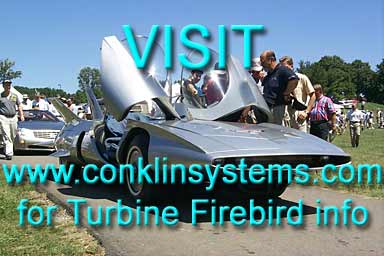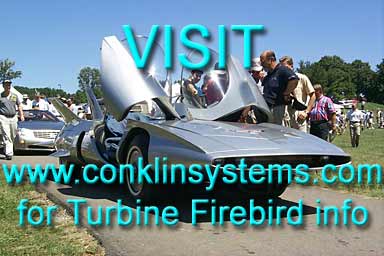
 |
I Drove the Firebird |
![]()
| The April 1954 issue of Motor Life magazine carried
two different Firebird articles, both recreated here.
This one was a short piece written by driver Mauri Rose
describing the actual experience of driving the Firebird
I, and the other focused on the
car and it's development. Though there are a couple statements that we know now to be incorrect, this is still a great piece and provides yet another interesting angle: how the Firebird was perceived by the 1950's auto-enthusiast. |
 |
| OVERALL, my major impression of the gas turbine car
is that it has very responsive acceleration. Moreover,
the Firebird at the same time has equally excellent
braking, even at good speeds. The braking never threatens
to swerve or spin the car. The steering is light and very
positive, and the ride is vibrationless, extremely easy. Anyone would get a great thrill and a feeling of pride out of driving the Firebird. |
 |
 Patient Mauri Rose gives seven-year-old Billy Fish of White Plains, NY the thrill of a lifetime during the GM Motorama display in New York City's famous Waldorf-Astoria hotel. |
With absolute sincerity I can say that the car itself is an outstanding job from both styling and engineering standpoints. Many men have devoted their intelligence, skill and labor to developing it. I considered it a privilege to drive the car-to enjoy the fruits of their efforts. WHEN I was asked to drive the XP.21 Firebird, the first question that came to mind was this: How would it feel to sit in front of the engine - and a gas turbine engine at that? Perhaps I'd feel out of place, having spent most of my life as a driver with an engine in front of me. We made our first run with the Firebird one gloomy, rainy, cold Sunday in November at General Motors' Proving Ground near Milford, Mich. Later, during the first week of December, we gave it more extended tests on GM's Desert Proving Ground near Mesa, Ariz. |
We needed to determine how the car would handle. Thus, when it was "fired up" and ready to go, I headed off the main loop of the Milford Proving Ground and began maneuvering over the curving, winding roads on level ground within the loop and began the handling tests.
Following me in a station wagon were engineers from GM Research Laboratories and GM Styling Section - the men who had designed and built the car and the engine. We had a two-way shortwave hookup so I could call off to them the readings from the instrument panel - it was outfitted with 16 dials and meters. They, in turn, could radio me any advice I needed.
During this run we cruised anywhere from 15 to 30 or 45 miles per hour, just so I cuuld get adjusted to my reaction to the Firebird and the Firebird's reaction to me. From the moment the Firebird began to roll, I felt absolutely at ease. Any preconceived notion that I would feel out of place ahead of the engine vanished immediately. Never did I have the impression the car would fishtail, swerve or swing from one side to another. And it never did - even during later test runs in Arizona.
| Within a minute or two after the car was in motion,
two other impressions came to mind instantly. First, the
steering was absolutely, marvelously true. The car wanted
to behave. It wanted to keep going straight ahead. It was
perfectly stable. This much of the Firebird's conduct, no doubt, cuuld be attributed to the design of the front suspension, the double wishbone with torsion bar spring. |
 Rose drove the Firebird at Michigan and Arizona GM test sites. Large air scoops behind the front wheels supply engine's intake air, small scoops beneath wing are for cooling exhaust and transmission. |
Also, the car was perfectly balanced with virtually a 50-50 weight distribution. I couldn't help being impressed by the workmanship that had been devoted to this experimental car. In short, it was ready - every minute detail.
Next I noticed the utter lack of vibration. As an engineer I was well aware of the fact that a turbine, with no reciprocating moving parts, probably is the smoothest power package in motion. It is.
The smoothness made me conscious of the car's chassis and suspension. In other words, the lack of vibration - vibration was something I had become accustomed to in years of race and test driving - left me free to think of other things.
It was like being accustomed to working in a room with a clock ticking - and then have the clock stop ticking. It was a little confusing for a moment. It was contrast.
The Firebird had traveled only a short distance when I noticed also that I would have to "tune in on a new range," so to speak. much of this was psychological.
NONETHELESS, a turbine-driven car has characteristics definitely different than a piston engine car. The engine idles at 8,000 rpm, but one can control the car at any speed from zero on up. However, the car continues to cruise right along when you close the throttle. Compression deceleration isn't there.
I had to learn to coordinate my reflexes and reactions with the forward movement of the car.
Obviously, a gas turbine with 370 horsepower propelling a car weighing about 2,500 pounds puts a considerable responsibility on the driver's shoulders. He has absolutely terrific acceleration at his disposal.
These mental adjustments can be made quickly. Once they're out of the way and out of mind, the driver of the Firebird can sit back and let the car guide itself. Its inherent stability makes it an easy vehicle to handle.
Throughout much of the rest of my maiden trip in the Firebird I concentrated most of the time on trying to let the engineers trailing me know - via shortwave - what was happening so far as the engine was concerned.
They, admittedly, were interested in such meter readings as the nozzle pressure in the engine's burners, the fuel pressure, the turbine nozzle box temperature and the other mental notes I was making on the engine's performance.
What we couldn't communicate by radio, we discussed in countless bull sessions whenever I stopped and crawled out of the cockpit. We would rehash every trial run of the proving ground loops like a congregation of football coaches replaying every offensive and defensive formation of the game.
At Arizona we spent more than a week, simply turning the car around the track and the mile and a quarter straightaway that bisects the Ground's five-mile circle. Our purpose was to continue getting the feel of the car and check the performance of the engine.
That's the whole article. It just cuts off there.
Questions or comments? Send them to
info2@conklinsystems.com
Conklin Systems 9905 Barnes Hwy
9905 Barnes Hwy Eaton Rapids, MI 48827
Eaton Rapids, MI 48827
Phone (517) 663-6418 Fax (517) 664-5802
Fax (517) 664-5802